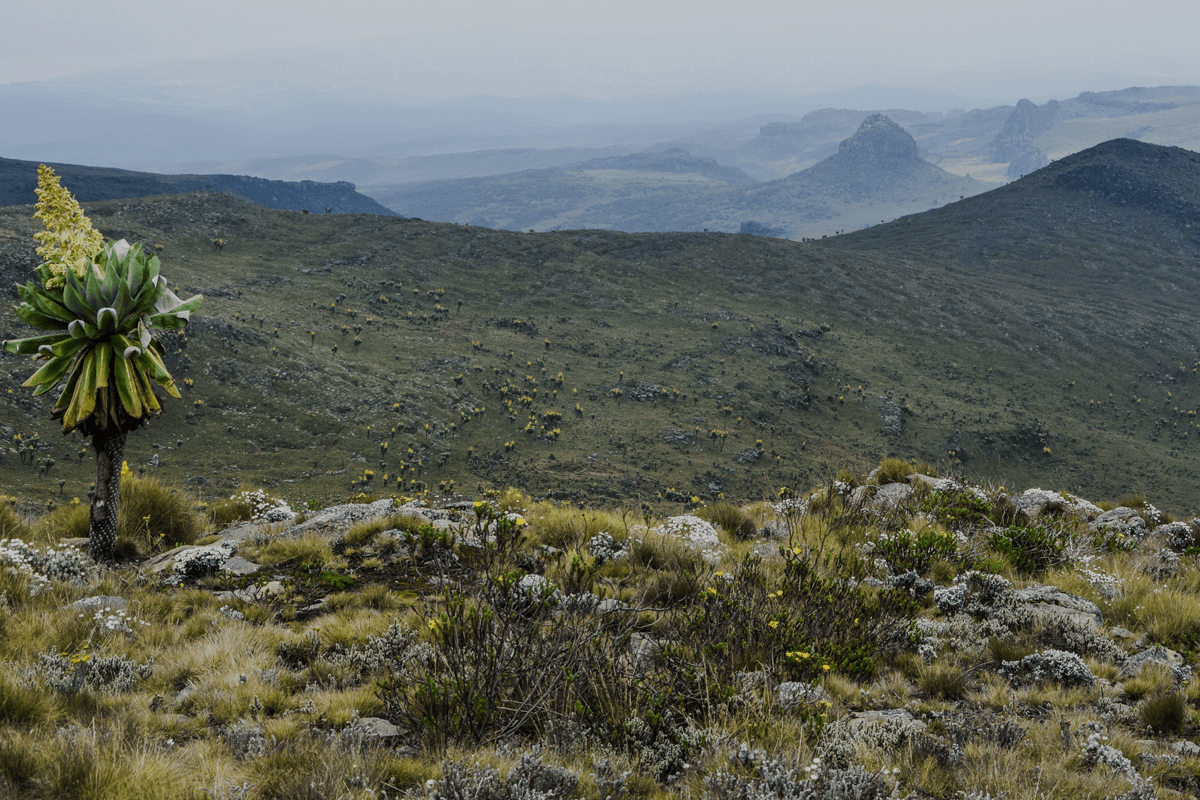Mount Kenya National Park covers Mount Kenya (5,199m). Mount Kenya is Africa’s second-tallest mountain from which the park derives its name. Mount Kenya National Park covers 715 square kilometers and the forest reserve surrounding it covers 705 square kilometers. This results in a total area of 1,420 square kilometers. Mount Kenya National Park is located in central Kenya about 200 kilometers northeast of Nairobi.
It was founded in 1949 to protect Mount Kenya, its wildlife, and the surrounding environment. The park, which was designated a UNESCO World Heritage Site in 1997, is also a Biosphere Reserve. Mount Kenya dominates the landscape of Mount Kenya National Park. This gives the park a unique afro-alpine ecosystem with alpine rivers and forests.

Mount Kenya is Africa’s second highest peak, after Mount Kilimanjaro (5,199 meters). Mount Kenya is made up of numerous peaks at varying altitudes. There are two major snow-covered peaks on the mountain: Batian (5199m) and Nelion (5188m).
The mountain slopes are covered in forest, bamboo, scrub, and moorland, with rock, ice, and snow on the high central peaks. These peaks create a beautiful view of the park.
A remarkable feature of Mount Kenya National Park is the varied bands of vegetation cover. Alpine forests, bamboo forests, timberline forests, heathlands, scrublands, and afro-alpine zones are found on Mount Kenya’s slopes. These various types of vegetation can be enjoyed when hiking on the mountain.
A variety of animal species can be found at the Mount Kenya National Park. Elephants, buffaloes, rhinos, and waterbucks are examples of mammals. In the park, you might also see lions, leopards, rock hyraxes, and several kinds of antelope. The forests are also home to smaller creatures such as antelope species and black-and-white colobus monkeys.
Many bird species dwell in Mount Kenya National Park’s various regions. Over 130 bird species have been identified, including endangered species and birds from the Afrotropical highlands.
Mountain Buzzard, Violet-backed Starling, Olive Pigeon, Eastern Bronze-napped Pigeon, Oriole Finch, Meyer’s Parrots, African Green Pigeon, Jackson’s Widowbird, Sharpe’s Long claw, Olive Ibis, Lammergeier, Ayres’s Hawk-Eagle, and African Crowned Eagle are some of the birds that can be found in Mount Kenya National Park.
Many ethnic groups, including the following, live on the borders of Mount Kenya Park.
These people live in Mount Kenya’s southeast. They regard Mount Kenya as a sacred location and think that it is the residence of their god Ngai. Because of this belief, they also construct their homes so that they face the mountain.
These people inhabit Mount Kenya’s eastern, northern, and northwest regions. The Ameru people are primarily farmers and livestock keepers.
The Ameru people think that their god, Murungu, used the mountain to ascend from the clouds. The peak was also given the Ameru name Kirimara, which means “mountain with white features.”
These are a semi-nomadic group of locals who live on the park’s outskirts. Originally, these people used the park’s area as a grazing area.
The Kikuyu people live in the mountain’s southern and western regions. The Kikuyu believe Mount Kenya is a sacred place where Gikuyu would meet their god. Gikuyu is the tribe’s father and the first person on Earth to ascend the mountain.
these served as hideouts for the Mau Mau rebellion.
Another cave on Mount Kenya is located before Shipton’s camp along the Sirimon route.
Mountain climbing is the most popular activity in Mount Kenya National Park. A climb to the top of Mount Kenya is an unforgettable experience. Glaciers, lakes, birds, and a variety of animals and plants can all be seen.
There are at least seven ways to ascend the mountain. The Naro Moru (four days) is the easiest, followed by the Sirimon and Chogoria. The Summit Circuit, Timau Route, and Burguret Route are all options. The third peak, Point Lenana (4.895m), is easily accessible to all hikers. The entire trek can take up to a week.
Mountain climbing allows you to see many animals, including elephants, buffaloes, and a variety of birds. Many animals, including elephants, buffaloes, and numerous bird species, can be seen while mountain climbing. Various vegetation covers dominate the slopes, with stunning views of lakes, tarns, glaciers, and peaks.
Climbing is greatest from mid-January to February and late August to September when the weather is dry. The trails can become slippery during the wet seasons, so plan to avoid them.
Mount Kenya National Park provides an exceptional opportunity for game viewing. Elephants, buffalos, antelopes, Mangoose, tree hyrax, black-fronted duikers, mole rats, bushbucks, waterbucks, elands leopards, black rhinos, and many more are guaranteed to be seen on a game drive, whether early in the morning or late in the evening.
Mount Kenya National Park has many camping areas where you can camp and enjoy the natural surroundings as well as the scenic views. These camping spots include Mackinders campsite in Teleki Valley along the Naro Moru route, Shipton’s hut, and many others.
Mount Kenya National Park also has caves that visitors can visit such as the Mau Mau Cave and Shipton’s Cave.
The presence of a wide range of birds in the park makes it a birder’s paradise. Birds can be seen on both lakes and mountain slopes.
The nearest airport to Mount Kenya is Nanyuki Airport, though there are several small airports near the area’s private lodges. A flight from Wilson Airport in Nairobi to Nanyuki Airfield, which is just outside Mount Kenya Park, is available.
The flight lasts 35 minutes significantly shortening the journey time.
Mount Kenya National Park is located approximately 175 kilometers (108 miles) from Nairobi along one of the three major routes to the mountain. From Nairobi, public or private transportation is used to reach the park via Nanyuki or Naro Moru.
The most popular route is the Nanyuki-Isiolo road. A good tar road circles the mountain’s base. It connects Naro Moru, Nanyuki, Meru, and Embu, the region’s main towns.
The best time to visit the park is between December and March. This is a dry season, so the hiking trails in the park are dry and there are clear views of the mountain peaks.
Tourists on a Kenya safari in the park can choose from a variety of accommodation options. These range from luxurious accommodations to mid-range and low-cost options.
